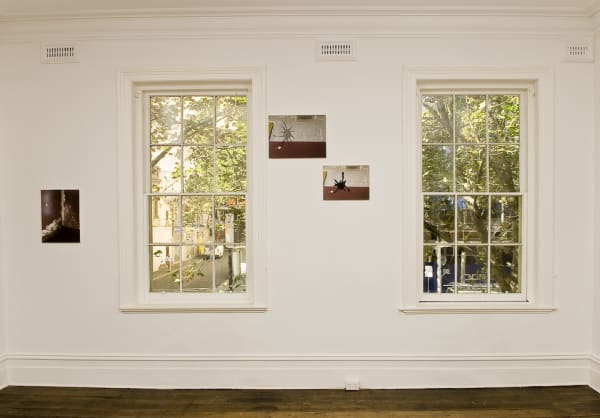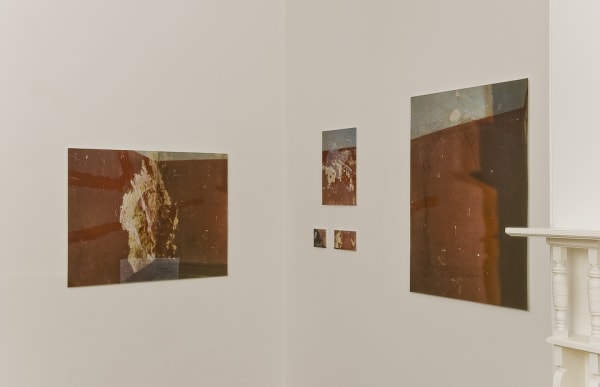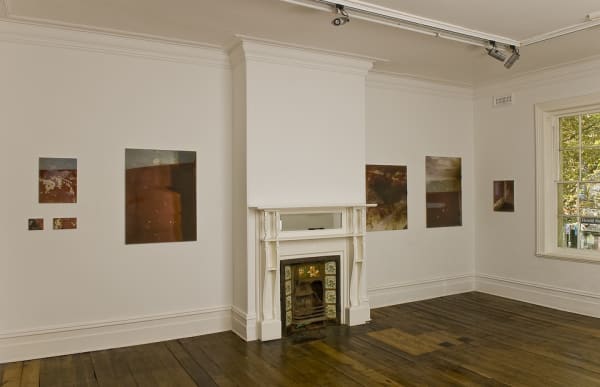Carolyn Eskdale: untitled after room
Carolyn Eskdale: untitled after room is a room of ink drawing on matte photographic prints.
The prints record a prior state of the gallery space when it was decorated with a heavy layer of brown, crimson and blue wall paint that had become scuffed, worn, flaked and scored. There are still remnants of the painterly schema outside the gallery and down the stairs, reminding us of what it was like before it became a white-cube. Eskdale’s drawing (and I intentionally mean this as a verb) is like a floating afterimage on the photo-as-ground; a family of knitted ink webs, striated lines, networked whorls and traced gestures, scumbles, ticks and spots. Her sheets of drawing are irregularly float-mounted on the gallery walls. Rather like a mosaic with parts erased or removed. She seemingly recovers the lost surface of the wall only to establish a new ground over-written with her drawing. There remains an imperfect correlation between each image and the obscured wall surface just behind.
So, as with much of her work Eskdale installs here a complex play between forms and their images, producing a slippage between the two, which implicates the viewer in things of material beauty and philosophical poise.
But what is this ‘after’ room? What is its nature? After what or when or whom does it occur? Is it simply a room that follows another in space and time? Is it the space of the viewer’s encounter with her drawing? Or does it allude to the condition of the gallery itself that whites-out the room’s link to an earlier progression of Bourke Street people? Certainly, Eskdale saw it as a box that records a history of light and reflections and shadows still imprinted long after some presence has gone. Perhaps however it is something that remakes the very idea of ‘room’- akin more to a metaphorical internal state?
As an exhibition it simultaneously evokes a contemplation of aesthetics, of aura and of shared memory. It partakes of vision, materiality and psychology. In it, the works appear fitfully representational. Consistently their photography functions as a witness, evidencing a fragmented truth about the room – its emptiness and nothingness – like Eugène Atget’s early photographs of the empty streets of Paris, of which Walter Benjamin said they were photographed like crime scenes. The cracks and stains and imperfections of Eskdale’s images have something of the forensic about them. They are sober, close-up and damaged. At times they draw us into corners or recesses hinting at abandonment. Yet the drawing and graphic mark making lifts the images into abstraction and a type of pure opticality – of sublime associations in colour and rhythm. Other times the drawing reverts to form and returns to stain the walls like graffiti. We wonder whether Eskdale represents things on the wall, in the space just in front of the wall or something in our eyes alone, like entoptic phenomena. It was polymath Goethe who first expressed the distinction between the reality of vision and what is within our eyes. It is this play with ground in its physicality, as illusion and as sign that distinguishes the work.
Eskdale’s practice is a type of art through inhabitation. She thinks through space and her thinking in the room is echoed in our own relations to her images. We peer up to ceilings, examine corners and sense the floor beneath out feet. As we scan around the room the works track a subtle colour shift - from warm reds through burnt umbers to cool greys and greens. Works, images, gestures are paired, doubled and restated as if a series of second thoughts overlays the encounter. We are reminded of its essential poetic and figurative identity.
In all her work Eskdale has sought to refine our relation to space and memory. Her drawing practice is embedded in this intrinsically sculptural practice, which is concerned with permeable sites and thresholds and the touch of her hands; hands that mould and knead, pick, sew, pluck and trace across fabrics, windows, walls, water and paper.
Benjamin wrote that buildings are ritualistically appropriated in a twofold manner: by touch and sight, citing Neolithic caves where, for the painter whose hand touched the wall – the vertical ground of the image as we understand it – the images depicted upon it dissolved the wall and temporal reality.
Carolyn Eskdale’s ‘untitled after room’ makes us witness to a similar act.
Greg Creek, March 2010












